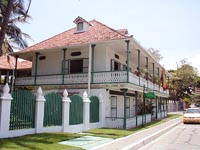
Just a short walk from the centre of Cartagena
is an historic house so entwined with the history
of Colombia that no visitor should miss it.
The house underwent a thorough restoration completed
just last month. It is the former residence
of Rafael Núñez: poet, journalist, author of
Colombia's National Anthem, creator of the Banco
Nacional, mastermind of its Constitution, and
the only President of Colombia to be elected
four times. Situated just outside the city wall
in Cabrero, it is easy to find: a grand old
two storey, Antillian Caribbean-style wooden
mansion painted white with green trim. Núñez
made it his home for 17 years, and his wife
Soledad Román Núñez lived here for a further
30 years after his death.
The building was originally built as a single
storey house by Soledad's father Manuel Román
in 1858, the second floor being added after
Núñez married Soledad. Passing through the entrance
corridor, the visitor usually joins a guided
tour which begins on the second floor in a beautiful
octagonal raised patio. This was the dining
room, and was open to the sea breeze and affords
a nice view of the garden, which today is home
to a period horse coach and some caged macaws.
The patio has louvers to blunt the afternoon
sun, and in Núñez' time this gave a view of
the ocean, a handy lookout since he was wary
of possible enemies coming from any direction.
Moving towards the front of the house you come
upon his ornate desk, where he wrote poetry
and his political thoughts. Photos of his time
in Panama - then a part of Colombia - are displayed
along with an extensive library pertaining to
the Delegates Council of 1886, the basis for
the Colombian Constitution which ended an intense
period of civil strife. There is also a bust
sculpted from life, his Will and Testament and
photos of his funeral.
Skirting around the veranda in front of the
living room, filled with beautiful antique furniture,
one comes to a dining room with plates and bowls
monogrammed SRN, his wife's initials. On the
ground floor there is a rustic kitchen with
a piedra de moler or grinding stones
for milling grain by hand, and a wall inscribed
with a memorial poem by his contemporary Rúben
Dario,Que Se Je?(Who Am I?). At the front
of the house is a collection of books and papers
about Núñez and Colombian history, and a small
office that houses the non-profit organization
which maintains the house.

 Núñez'
administration is remembered for ending the
bloody period of chaos and internal wars which
plagued Colombia from 1863-1886, a time which
saw no less than 34 different Presidents. Núñez
was born in 1825, and was an elected Congressman
by 1853. He spent some time in Europe as a consul
in Liverpool and Le Havre before returning to
Colombia in 1875. He aligned with the Independent
faction of the Liberals, and after signing a
shaky coalition with the Conservatives, he defeated
the Radical faction both at the ballot box and
on the battlefield: under his command, Cartagena
repelled Gaitán Obeso who laid siege to Cartagena
in 1885 with 3,000 rebels. His famous motto,
now painted above the entrance to his residence,
Regeneration or Catastrophe, could not
have been better with hindsight. He made peace
with the Catholic Church, ending a destabilizing
anti-clerical campaign. Soledad and Rafael were
both born in Cartagena, Soledad being the oldest
of 17 children, from a strict Catholic family.
He raised eyebrows living with her, because
the Church did not recognise his divorce from
his first wife, Dolores Gallego. After his fourth
term, he handed power to his Vice President,
Miguel Antonio Cano. Núñez'
administration is remembered for ending the
bloody period of chaos and internal wars which
plagued Colombia from 1863-1886, a time which
saw no less than 34 different Presidents. Núñez
was born in 1825, and was an elected Congressman
by 1853. He spent some time in Europe as a consul
in Liverpool and Le Havre before returning to
Colombia in 1875. He aligned with the Independent
faction of the Liberals, and after signing a
shaky coalition with the Conservatives, he defeated
the Radical faction both at the ballot box and
on the battlefield: under his command, Cartagena
repelled Gaitán Obeso who laid siege to Cartagena
in 1885 with 3,000 rebels. His famous motto,
now painted above the entrance to his residence,
Regeneration or Catastrophe, could not
have been better with hindsight. He made peace
with the Catholic Church, ending a destabilizing
anti-clerical campaign. Soledad and Rafael were
both born in Cartagena, Soledad being the oldest
of 17 children, from a strict Catholic family.
He raised eyebrows living with her, because
the Church did not recognise his divorce from
his first wife, Dolores Gallego. After his fourth
term, he handed power to his Vice President,
Miguel Antonio Cano.
Rafael
Núñez died in Cartagena on the 18th of September
1894, and is buried alongside his wife, in the
Ermita de Cabrero, a quaint little church opposite
his house.
Note: no photography is allowed inside the house.
Photo
and story copyright of Glen David Short. Posted
8th May 2002. His adventure travelogue, `An Odd Odyssey: California to Colombia
by bus and boat through Mexico and Central America'
is available from Trafford Publishing.
-
B A C K -
Text
and Photos Copyright 2005 Glen David Short
|